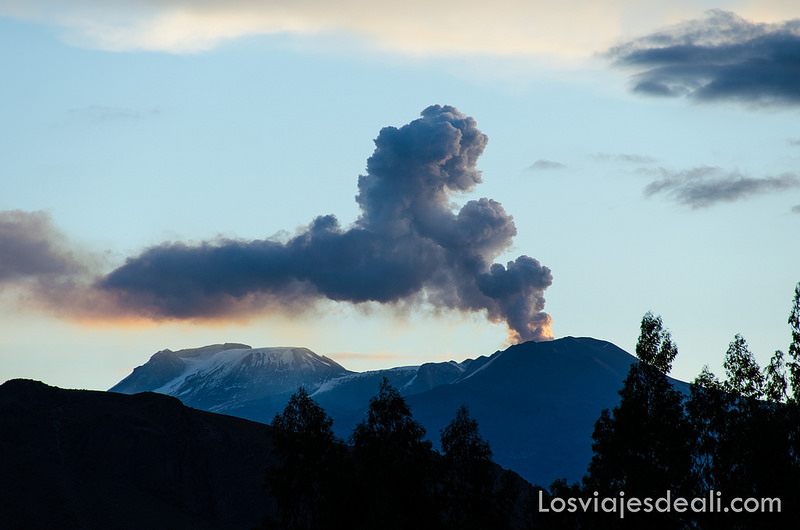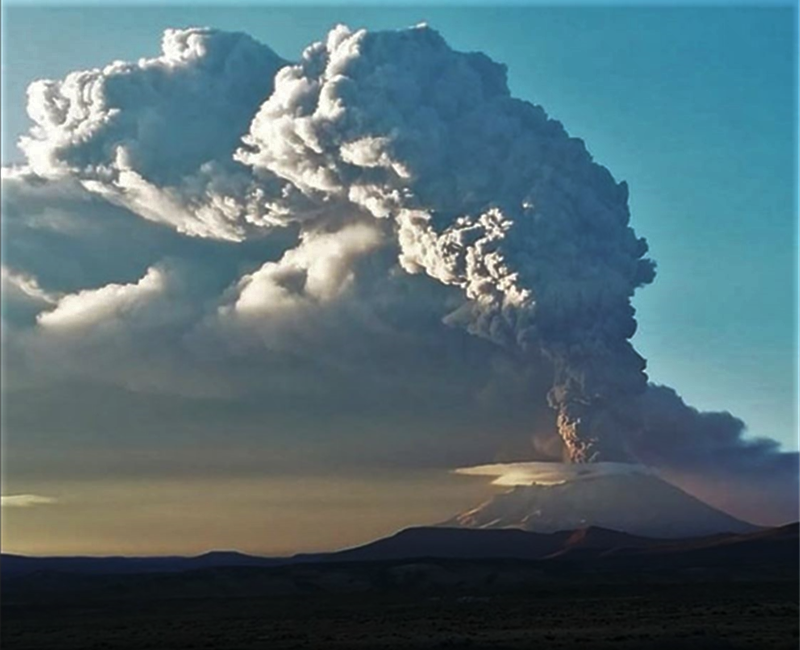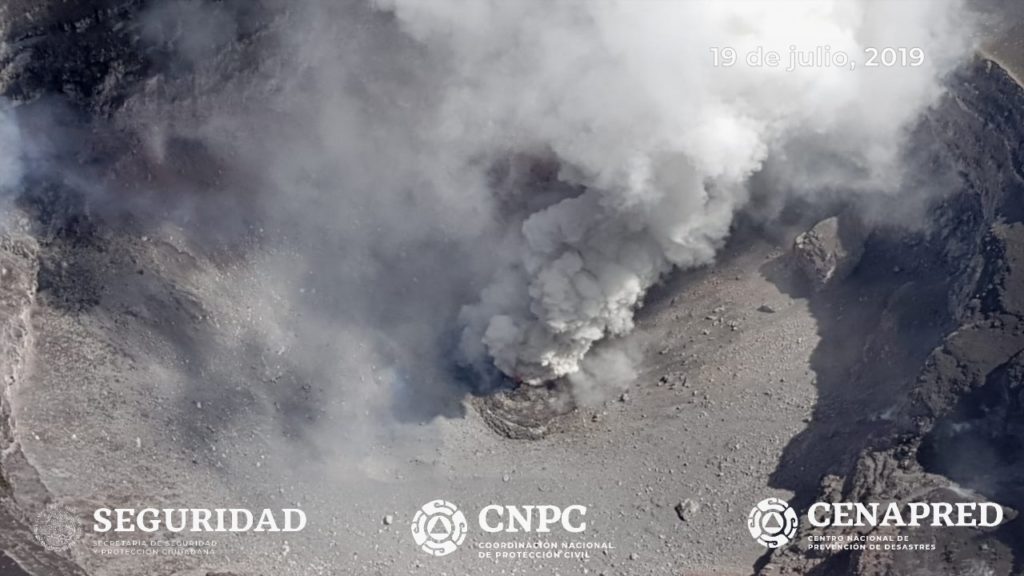July 23 , 2019.
Peru , Sabancaya / Ubinas :
Sabancaya: Analysis period: July 15-21, 2019 . Arequipa, July 22, 2019
Alert level: ORANGE
The Geophysical Institute of Peru (IGP) reports that the eruptive activity of the Sabancaya volcano remains moderate. Therefore, for the following days, no significant change is expected.
The analysis of the recordings obtained from the seismic network of the Sabancaya volcano for the period from July 15 to 21, 2019, made it possible to identify the occurrence of about 2144 earthquakes of volcanic origin, the highest percentage being associated with the movements of magmatic fluids. During this week, there was an average of 16 explosions per day of moderate to low intensity.
The monitoring of the deformation of the volcanic structure, using GNSS data (processed with fast orbits), presents no significant anomalies. Visual surveillance, using surveillance cameras, allowed us to identify the appearance of columns of gas and ash up to 3.2 km above the summit of the volcano , scattered in the eastern, south-eastern and southern sectors of Sabancaya. Satellite monitoring identified 4 thermal anomalies on the volcano from 1 MW to 22 MW, associated with the presence of a hot body near the surface and the occurrence of continuous explosions.
RECOMMENDATIONS: Do not approach within a radius of less than 12 km around the crater.
Ubinas: Alert ash fall , Posted on 22/07/2019 08:10
Ash Clouds Direction: Southeast and East
Range of dispersion: 20 km
Cities:
Villages in the districts of Ubinas, Lloque and Chojata.
Recommendations:
Ashes can cause environmental problems and affect people’s health.
Before the ashes fall, we recommend:
a) Protect your eyes with glasses and use masks to protect the airways.
(b) That the competent authorities and institutions make a permanent assessment of the impact of ashes on water, soil, air and human health.
Source : IGP Pérou .
Photos : Losviajesdeali.com , IGP.
Indonesia , Anak Krakatau :
Level of activity at Level II (WASPADA).
Since yesterday and until this morning, the volcano was covered with fog. The smoke from the crater is not observed. The weather is cloudy. Low winds are trending east, west and northwest.
Through the seismographs, on July 22, 2019, it was recorded:
Continuous tremor with amplitude 1 – 5 m, dominant value: 3 mm
Recommendation: People / tourists are not allowed to approach the crater within 2 km.
VOLCANO OBSERVATORY NOTICE FOR AVIATION – VONA.
Issued: July 23 , 2019.
Volcano: Anak Krakatau (262000)
Current Aviation Colour Code: ORANGE
Previous Aviation Colour Code: orange
Source: Anak Krakatau Volcano Observatory
Notice Number: 2019KRA137
Volcano Location: S 06 deg 06 min 07 sec E 105 deg 25 min 23 sec
Area: Lampung, Indonesia
Summit Elevation: 502 FT (157 M)
Volcanic Activity Summary:
Eruption with volcanic ash cloud at 02h11 UTC (09h11 local).
Volcanic Cloud Height:
Ash-cloud is not visible
Other Volcanic Cloud Information:
Anak Krakatau volcano is not clear.
Remarks:
Eruption recorded on seismogram with maximum amplitude 46 mm and duration 35 second.
Sources : PVMBG , Magma Indonésie .
Nicaragua , Masaya :
INETER reports a small explosion on the Masaya volcano.
The Nicaraguan Institute of Territorial Studies (INETER) announced this Sunday, July 21, 2019, a small explosion occurred in the crater Santiago of Masaya volcano.
At 4:55 pm, Sunday, through the cameras installed on the volcano, an explosion was observed in the crater Santiago, which emitted ashes and fragments of rocks on the contour of the volcano without touching anyone.
This is a low-energy event that occurs when one of the crater’s internal ducts becomes clogged and holds high-pressure gases, which accumulate energy to produce an explosion, expelling ashes and sometimes rocks.
It is recommended to place the volcano under special surveillance for an additional 48 hours in case another explosion occurs. In case of occurrence, it could be of the same magnitude as that occurred this Sunday afternoon or less than this one. This type of event occurs on this volcano every 3 years.
INETER is closely monitoring the activity of the Masaya volcano and will report any situation that may occur.
Source : tn8.tv.
Vidéo : Alejandra Sanchez.
Mexico , Popocatepetl :
Report on the overflight of the Popocatepetl volcano on 19 July. Sunday, July 21st, 2019.
The warning light of Popocatepetl is yellow-phase 2. CENAPRED urges not to approach the volcano and especially the crater, because of the danger represented by falling rock fragments.
The Popocatepetl volcano is monitored continuously 24 hours a day. Any change of activity will be reported as soon as possible.
On July 19, with the support of the federal police, an overflight was made to recognize the state of the crater of the volcano Popocatépetl. During the flyover, photographs were obtained that identified the presence of a new dome with a diameter of 70 meters and a thickness of 15 meters. On the other hand, the internal crater retains its dimensions. The presence of the dome number 83 and its possible destruction are confirmed, due to recorded explosions and ash-containing emissions, which reached certain parts of Mexico City on Saturday, July 20, as well as minor explosions projecting incandescent fragments on the contour of the volcano.
During the last 24 hours, thanks to the monitoring systems of the Popocatepetl volcano, 256 exhalations have been identified, accompanied by water vapor, gas and light amounts of ash. In addition, four explosions were recorded. Three yesterday at 14:07, 17:12 and 23:59, the latter issued ballistic fragments on the North-East side. The fourth explosion was recorded today at 8:12 am. In addition, 547 minutes of tremor were recorded.
Today morning and at the time of writing this report, the visibility of the volcano is continuous, whatever the event, it will be dispersed in the West direction.
The warning light of Popocatépetl is at YELLOW PHASE 2.
Source : Cenapred .



